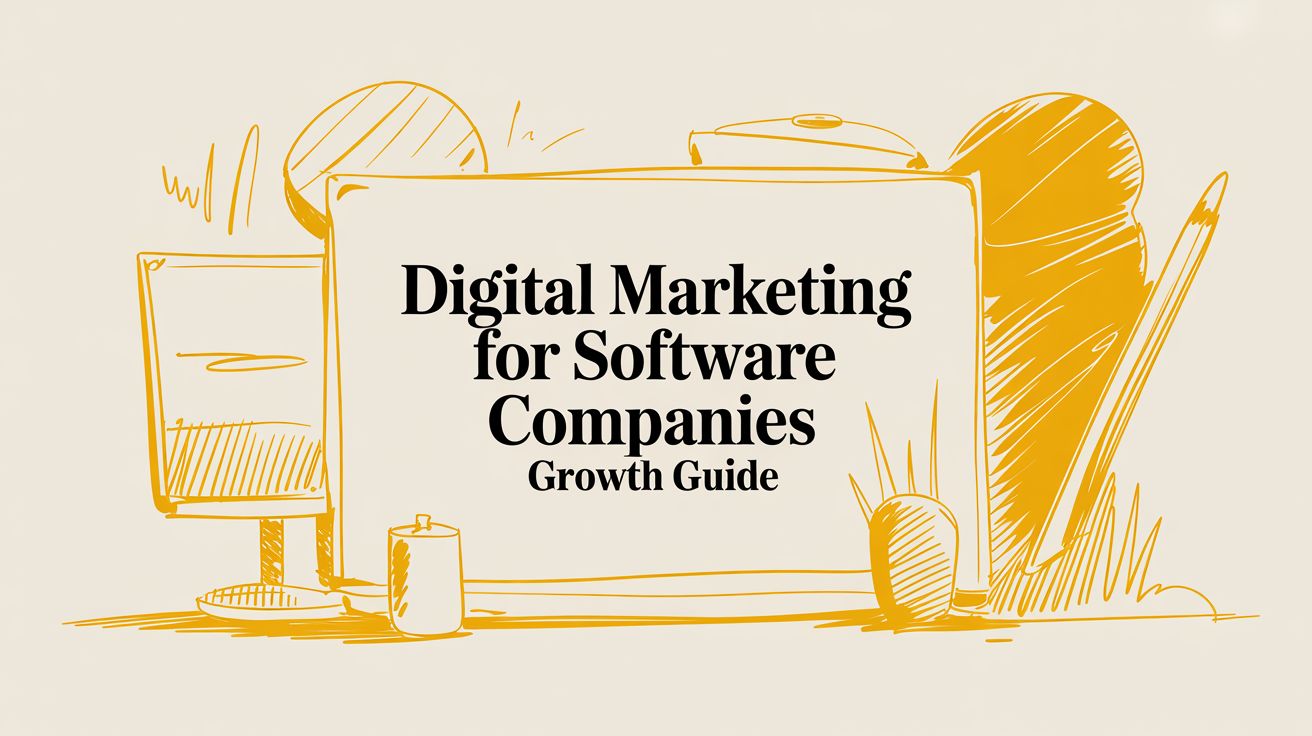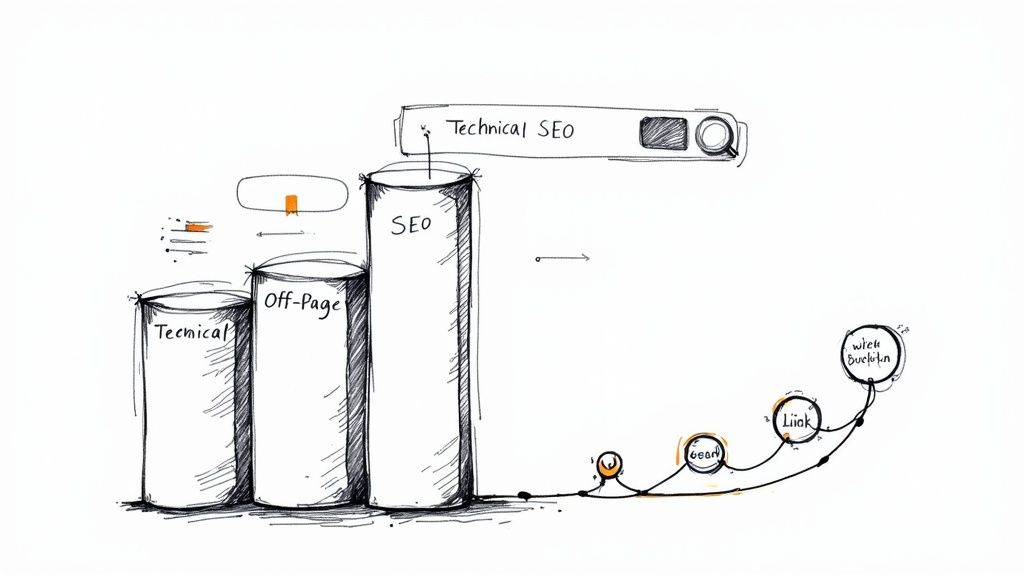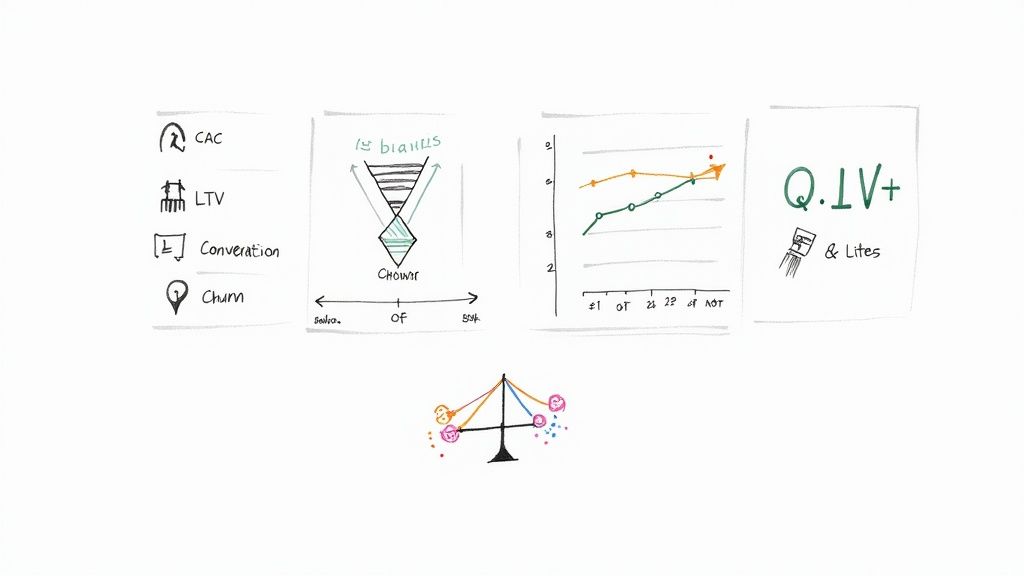Digital Marketing for Software Companies Growth Guide

When you're marketing a software company, you're not just casting a wide net and hoping for the best. It’s more like precision engineering. Unlike marketing a t-shirt or a cup of coffee, selling software demands a specialized approach to navigate long sales cycles, explain complex products to smart users, and keep them around for the long haul. This guide is your roadmap for turning intricate features into undeniable business value.
Why Generic Marketing Fails Software Companies

Think about trying to tune a high-performance race car with a generic wrench from a home toolkit. Sure, you might be able to loosen a bolt, but you'll never tap into its real power. That’s exactly what happens when software companies try to apply general marketing tactics to a highly specialized industry.
Standard marketing strategies just don't work here because they're not built to handle the unique challenges of selling software. The path from a curious prospect to a loyal, paying customer is rarely a straight line. It's a winding road that requires trust, education, and constant engagement.
The Software Marketing Difference
The heart of the problem is that software isn't a simple product; it's a sophisticated solution to a very specific, and often technical, problem. Because of this, your marketing has to do more than just get your name out there. It needs to educate potential customers, build their confidence in your solution, and show them tangible value before they ever think about buying.
Here’s what makes software marketing a completely different game:
- Longer Sales Cycles: B2B software decisions often involve entire teams and can take months of evaluation. Your marketing has to keep those leads warm and engaged throughout that entire journey.
- Need for Deep Education: People won't buy what they don't understand. Your content must break down complex features and translate them into clear business outcomes.
- Emphasis on Retention: For any SaaS business, getting a new customer is only half the battle. Marketing's job doesn't stop at the sale; it extends into customer onboarding, engagement, and ultimately, fighting churn.
A generic approach treats every customer the same. But great software marketing is all about understanding the specific needs of technical buyers and decision-makers. It’s about speaking their language and solving their problems.
This guide is designed to give you that specialized toolkit your high-performance software company needs. We’ll skip the broad strokes and dive right into actionable strategies for positioning your product, driving organic growth with SEO, generating qualified leads, and using data to get better every day. You'll walk away with a practical framework to build a marketing engine that doesn’t just attract users, but turns them into raving fans.
Defining Your Ideal Customer and Market Position

Great marketing for a software company isn’t about shouting your features from the rooftops. It’s more like a quiet, focused conversation with exactly the right person. Before you can craft a message that actually lands, you need to know who you’re talking to and why they should listen to you over a dozen other options.
This whole process kicks off when you stop thinking in vague terms like "small businesses" or "project managers." To really connect, you have to build a detailed Ideal Customer Profile (ICP). Think of it like a character sketch for the perfect company that would get the most out of your software.
It goes way beyond just company size or industry. A powerful ICP gets into the nitty-gritty of their operations, how comfortable they are with technology, and the business problems that genuinely keep their leaders up at night.
Building Your Ideal Customer Profile
A truly effective ICP is built on data, not just hunches. It’s a blend of hard company details and the very human drivers behind a purchasing decision. The best place to start? Look at your favorite existing customers—the ones who use your product constantly, stick around for the long haul, and see massive value in what you do.
Figure out what makes them so successful and hunt for the common threads. Here are the key ingredients for a solid ICP:
- Firmographics: Get the basics down. What industry are they in? How big is the company (both in revenue and employee count)? Where are they located?
- Technographics: What other tools are they already using? Understanding their tech stack helps you position your product as a seamless addition, not a disruptive headache.
- Pain Points: What specific, costly problems does your software actually solve for them? Don't be generic. Get specific, like "wasting 20 hours per week on manual data entry" or "suffering from a 15% project delay rate."
- Business Goals: What are they ultimately trying to accomplish? Maybe it's boosting efficiency, cutting down on customer churn, or breaking into a new market.
A well-defined ICP is the compass for your entire marketing strategy. It ensures every blog post, ad campaign, and social media update is aimed squarely at the people who are most likely to become your best customers.
Carving Out Your Market Niche
Once you know who you’re talking to, the next move is to understand the world they live in. This is where competitive analysis comes in. You’re not just making a list of other companies; you're looking for an opening—a unique space in the market that your software can completely own. For some practical steps on this, check out our guide on how to conduct competitor analysis.
Your goal here is to nail down your Unique Value Proposition (UVP). This is the clear, punchy statement that explains how your product solves your customer's problem better than anyone else. It's the core of your messaging and the reason a prospect will choose you.
The fight for attention is intense. The global digital advertising market is expected to hit a staggering $843 billion in 2025. With major companies pouring 72% of their marketing budgets into digital channels, a bland, generic message is guaranteed to get lost in the noise. A sharp, distinct market position isn't just nice to have; it’s non-negotiable. You can explore comprehensive digital marketing statistics to see just how crowded the field is.
Translating Features into Benefits
Finally, with your ICP and UVP locked in, you can start crafting messages that actually resonate. One of the most common traps software companies fall into is talking too much about what the product does (its features) instead of why any of it matters (the benefits).
Your audience is smart, but they’re also incredibly busy. They don’t really care about your "AI-powered algorithm." What they care about is the "automated, error-free reporting that saves them a full day of work each month."
Here’s a simple way to think about this translation:
| Feature | Benefit | Business Outcome |
|---|---|---|
| Real-time analytics dashboard | Instantly track project progress without manual updates | Make faster, data-driven decisions to keep projects on budget |
| Automated workflow triggers | Reduce manual hand-offs between team members | Increase team productivity by 25% and eliminate bottlenecks |
| Centralized document repository | Ensure everyone has access to the latest version of files | Reduce costly errors caused by outdated information and improve compliance |
When you consistently frame your product this way, you transform it from a list of technical specs into an indispensable tool for achieving real business goals. This customer-first mindset is the bedrock of every successful software marketing strategy.
Mastering SEO for Organic Software Growth

Search Engine Optimization, or SEO, is all about making sure your software shows up when people are actively searching for a solution to their problem. Think of it as building a direct, well-lit highway from a customer's Google search straight to your product's front door. Without it, even the most innovative software can get lost in the noise.
For any software company, a solid organic presence is a massive advantage. While paid ads give you a quick traffic boost, SEO builds a lasting growth engine that consistently brings in high-quality leads. The numbers don't lie: organic search is responsible for over 50% of all website traffic, making it a non-negotiable part of your marketing strategy.
A great SEO strategy really comes down to three key areas: a technically solid website, content that speaks directly to your customers' needs, and building a reputation that search engines trust.
The Three Pillars of Software SEO
To get real results, you have to approach SEO from all sides. It's like a three-legged stool—if one leg is weak, the whole thing topples over.
Technical SEO: This is the foundation. It’s all about making sure your site’s infrastructure is in good shape. Things like fast page speeds, a mobile-friendly design, and a logical structure allow search engines to easily find and understand your content. A slow, confusing site is a dead end for both users and Google.
On-Page SEO: This is where your content takes center stage. It involves digging into keyword research to figure out exactly what your ideal customers are typing into the search bar. From there, you craft pages—with optimized titles, headings, and copy—that give them the answers they're looking for.
Off-Page SEO: This pillar is all about building your site’s authority and credibility across the web. The main way to do this is by earning high-quality backlinks (links from other reputable sites to yours). Each backlink acts like a vote of confidence, telling search engines that you're a trustworthy source of information.
SEO isn’t just a game of ranking for keywords. It's about positioning your software as the go-to solution for a specific problem. When someone searches for an answer, you want your brand to be the first and best one they find.
Each page on your software website has a unique job to do. The table below breaks down how to tailor your SEO strategy for the pages that matter most.
Strategic SEO Focus for Different Software Pages
| Page Type | Primary SEO Goal | Target Keyword Intent |
|---|---|---|
| Homepage | Build brand authority and provide a high-level overview. | Branded keywords (e.g., "Slack," "Asana login") |
| Features Page | Showcase specific solutions and product benefits. | Solution-aware keywords (e.g., "team collaboration tool," "Gantt chart software") |
| Pricing Page | Capture users ready to buy. | Transactional keywords (e.g., "HubSpot pricing," "Trello cost") |
| Blog Posts | Attract top-of-funnel traffic and educate the market. | Informational keywords (e.g., "how to manage remote teams," "what is CRM") |
| Comparison Pages | Win over prospects comparing you to competitors. | Commercial investigation keywords (e.g., "ClickUp vs Monday," "best Jira alternatives") |
By aligning your SEO efforts with the purpose of each page, you create a more effective and cohesive user journey.
Keyword Research Across the Buyer's Journey
Smart keyword research is about more than just targeting your product's name. You need to connect with customers at every single stage of their decision-making process, from the first inkling of a problem to the final click to buy.
- Awareness Stage (Top of Funnel): At this point, people know they have a problem but aren't sure what the solution is. They're searching for things like "how to improve team collaboration." Your blog is the perfect place to target these "how-to" and "what is" informational queries.
- Consideration Stage (Middle of Funnel): Now, they're starting to compare different types of solutions. Searches might look like "project management software vs spreadsheet" or "best tools for remote teams." This is where your comparison guides and detailed feature pages can shine.
- Decision Stage (Bottom of Funnel): They’re ready to pull the trigger and are comparing specific brands. They use transactional keywords like "Asana pricing" or "Trello alternatives." Your pricing, features, and competitor pages need to be perfectly optimized for these high-intent searches.
Targeting keywords across this entire journey allows you to meet potential customers wherever they are and guide them toward a solution. Getting a handle on these patterns is crucial, and you can learn more about how to analyze website traffic to see which keywords are actually driving conversions.
Building Authority with Strategic Backlinks
On the internet, backlinks are like currency. The more links you have from high-quality, relevant websites, the more authority you have in Google's eyes. For software companies, this is essential for building trust.
Here are a few proven ways to earn those valuable backlinks:
- Guest Blogging: Write genuinely helpful articles for respected industry blogs and include a natural link back to a resource on your own site.
- Software Review Sites: Make sure you're listed and have positive reviews on platforms like G2, Capterra, and TrustRadius. These links carry serious weight and send qualified traffic your way.
- Create "Link-Worthy" Resources: Develop something so valuable that people can't help but link to it. Think original research reports, free tools that solve a small problem, or the most comprehensive guide on a topic in your industry.
By carefully managing your site's technical health, creating relevant on-page content, and building off-page authority, you can build an SEO machine that fuels your growth for years to come.
Content and Email: Your One-Two Punch for Lead Generation
Think of SEO as the highway that brings traffic to your digital doorstep. But what happens once visitors arrive? That's where your content comes in. It's the engine that powers their journey from a curious browser to a paying customer. For software companies, content isn't just about filling a blog—it’s about strategically answering questions, building trust, and making your solution the obvious choice.
Great content marketing gets inside your ideal customer's head. You figure out their questions at every stage and provide the answers before they even have to ask. When you do this right, you become a trusted advisor, and the sale feels like the next logical step, not a pushy pitch. This entire process usually follows a predictable path.
Mapping Content to Your Customer's Journey
Your content plan should be a direct reflection of your customer's buying process. You need to meet them where they are, whether they're just realizing they have a problem or they're ready to pull out their credit card.
Top of the Funnel (ToFu): The "Awareness" Stage
At this point, people know they have a problem, but they might not know your software even exists. Your goal is to educate, not to sell. Talk about their pain points in broad strokes.- Good examples: Blog posts like "5 Signs Your Team Has Outgrown Spreadsheets," comprehensive whitepapers, or insightful industry reports.
Middle of the Funnel (MoFu): The "Consideration" Stage
Okay, now they're actively looking for a solution. They're comparing different types of software and trying to figure out the best approach. Your content should guide their evaluation and show them why your way is the right way.- Good examples: Detailed case studies showing real customer wins, webinars that offer a live look at your product, or side-by-side comparison guides.
Bottom of the Funnel (BoFu): The "Decision" Stage
This is it. They're down to a shortlist of vendors and are this close to making a decision. Your content needs to be direct and help them overcome any last-minute hesitation.- Good examples: An ROI calculator that proves the financial benefit, crystal-clear product documentation, or guides to get the most out of a free trial.
The real art of content marketing is answering your customers' questions before they have to ask. When you consistently deliver that kind of value, you earn the right to ask for their business.
From Content Viewers to Active Leads with Email
Putting out fantastic content is a great start, but it's only half the job. You need a way to turn those anonymous readers into actual leads you can talk to. This is where email marketing steps in, bridging the gap between your content and your sales team.
It all kicks off with a lead magnet—something valuable you offer in exchange for an email address. This could be that ToFu whitepaper, a MoFu webinar, or a BoFu checklist. Once someone gives you their email, they're not just a visitor anymore; they're a lead.
From there, you can use automated email workflows, often called nurture sequences, to build a relationship. These aren't spammy sales blasts. They're a series of helpful, targeted emails sent over several days or weeks. For example, if someone downloads your whitepaper on project management, the sequence might look like this:
- An immediate email with a link to a relevant case study.
- A few days later, an invitation to a webinar about improving team efficiency.
- A week later, a soft offer to start a free trial of your software.
This methodical approach keeps your brand top-of-mind and gently guides people toward a sale. It’s incredibly effective, too. Companies that master lead nurturing generate 50% more sales-ready leads at a 33% lower cost. By pairing a smart, full-funnel content plan with a thoughtful email strategy, you build a machine that turns traffic into revenue.
To really get this machine humming, you’ll need to master the fundamentals. You can explore a variety of essential content marketing techniques that form the foundation of any successful strategy.
Scaling Growth with Paid Ads and Social Media
While SEO and content marketing are busy building you a powerful, long-term growth engine, sometimes you just need to hit the accelerator. Paid advertising and a smart social media presence give you that immediate burst of speed to capture market share, pull in high-quality leads, and get your software in front of the right people, right now.
Think of your organic marketing as building a railroad—it’s a massive, valuable asset that will serve you for years, but laying the track takes time. Paid ads are like chartering a private jet. You can get to your destination quickly and with incredible precision, targeting the exact customers you need to reach.
Capturing High-Intent Leads with Google Ads
When someone has a problem they need to solve with software, their first stop is almost always Google. They aren't just browsing; they are actively hunting for a solution, which makes them some of the most valuable leads you can possibly find. This is precisely where Google Ads becomes an essential tool for any software company.
By bidding on specific, bottom-of-the-funnel keywords like "best CRM for small businesses" or "project management software integration," you put your solution directly in their path at the exact moment they need it most. The secret is to align your ad copy and landing page perfectly with what the user searched for, creating a frictionless journey from their problem straight to your solution.
For software companies, a dedicated B2B SaaS Marketing Playbook for Google Ads can be a game-changer, offering strategies designed for the unique challenges of marketing complex products, not just generic advice.
Hyper-Targeting Decision-Makers on Paid Social
If Google Ads is about capturing existing demand, paid social media is where you create it. For B2B software companies, platforms like LinkedIn are goldmines because of their incredibly detailed targeting options. You can move far beyond simple demographics and reach people based on their:
- Job Title: Target CTOs, marketing managers, or HR directors directly.
- Company Size: Zero in on startups, mid-market companies, or enterprise-level organizations.
- Industry: Pinpoint specific sectors like healthcare, finance, or manufacturing.
- Skills and Group Memberships: Find people with specific technical expertise or who belong to relevant industry communities.
This kind of precision means your ad budget isn't wasted on an audience that will never buy. You can run campaigns to promote a whitepaper, drive sign-ups for a webinar, or offer a free trial, all within the platform, filling your pipeline with prospects who are a perfect fit.
Paid advertising isn't about outspending the competition. It's about outsmarting them with superior targeting, compelling creative, and a deep understanding of your customer's journey.
Building Community and Trust with Organic Social Media
Your paid advertising becomes exponentially more effective when it’s backed by a genuine, active presence on social media. Organic social is where you build a community, show off your brand's personality, and earn the trust that turns prospects into loyal advocates.
LinkedIn is the perfect place to establish yourself as a thought leader by sharing insightful articles, company news, and expert commentary. Meanwhile, Twitter (now X) is fantastic for jumping into real-time conversations, keeping an eye on industry trends, and connecting with influencers. This authentic engagement provides the crucial social proof that validates the claims you’re making in your ads.
The influence of what people see on social media is undeniable. A staggering 76% of users say it has swayed their purchasing decisions. With the digital video ad market projected to hit $72.4 billion in 2025, it’s clear where audience attention is going. This shift is especially strong among younger buyers, as 41% of Gen Z consumers now turn to social media first for information—even over traditional search engines. You can discover more insights about these digital marketing statistics to see how modern buyers are finding new products.
When you integrate your paid and organic strategies, you create a powerful flywheel. Paid ads drive awareness and bring new people into your world, while your organic content nurtures them, builds trust, and keeps your brand top-of-mind. It's this balanced approach that truly maximizes your ad spend and builds a sustainable model for scalable growth.
Measuring What Matters for Software Marketing

In software marketing, it's incredibly easy to get buried in data. The problem is, most of it is just noise. You can drown in a sea of "vanity metrics"—things like social media likes or total page views—that look great on a report but don't actually tell you if you're making money.
To make genuinely smart decisions, you have to cut through that noise and focus on the numbers that actually move the needle. These are your Key Performance Indicators (KPIs), and they connect your marketing spend directly to business growth. They're the proof that your strategy is working.
The Core KPIs for Software Growth
Shifting away from surface-level stats means getting serious about a few core metrics. These KPIs are the bedrock of any solid marketing strategy, giving you a clear picture of how much it costs to get a customer and how much they're worth over time.
- Customer Acquisition Cost (CAC): Put simply, this is what you spend in sales and marketing to land one new customer. Knowing your CAC is the first step to understanding if your marketing is efficient or just expensive.
- Customer Lifetime Value (LTV): LTV is the total revenue you can reasonably expect from a single customer throughout their entire time with you. A high LTV is a clear signal of a healthy, sticky product and a sustainable business.
- Trial-to-Customer Conversion Rate: If you run a SaaS company, this metric is your lifeblood. It’s the percentage of people who go from a free trial or freemium plan to a paid subscription. This tells you how well your product sells itself once people get their hands on it.
- Churn Rate: This is the percentage of customers who cancel their subscription in a given period. High churn is a silent killer for growth; it’s like trying to fill a leaky bucket. You have to keep it in check.
The real magic happens when you look at how these metrics interact. The LTV-to-CAC ratio is the ultimate health check for a software business. A strong ratio, ideally 3:1 or higher, confirms that you're acquiring customers profitably.
Building Your Analytics Dashboard
Of course, tracking these numbers requires the right setup. You can't manage what you don't measure, which is why a central analytics dashboard is non-negotiable. Tools like Google Analytics 4, Mixpanel, or HubSpot give you the power to see the entire customer journey.
The goal is to connect the dots. You want to follow a user from their very first touchpoint—whether it's reading a blog post or clicking an ad—all the way through to signing up for a trial and becoming a paying customer. This end-to-end view is what makes attribution possible, showing you which channels are really delivering your best customers.
You might find, for example, that your paid ads generate a ton of trial signups, but the users who find you through organic search stick around longer and have a much higher LTV. That single insight tells you exactly where to invest your next dollar. To truly master this, you need a solid foundation in accurately measuring your marketing ROI.
By zeroing in on these core metrics and using analytics to piece together the full story, you turn your marketing department from a cost center into a predictable revenue engine. This is how you justify your budget, optimize with confidence, and prove marketing's direct impact on the bottom line.
Have Questions? We've Got Answers
Stepping into the world of digital marketing for a software company can feel like navigating a maze. A lot of questions pop up. Here are some of the most common ones I hear, along with some straight-to-the-point answers to help you find your way.
How Much Should We Actually Be Spending on Marketing?
There’s no one-size-fits-all answer here. Your budget really hinges on your company's age, size, and ambition. A young startup trying to make a name for itself might pour 20-50% of its revenue right back into marketing to grab market share. It's an aggressive but necessary move.
On the other hand, more established players with a solid footing often settle into a more predictable groove, allocating around 10-15% of their annual recurring revenue (ARR).
The real metric to obsess over is your LTV to CAC ratio. You want a customer's lifetime value to be at least 3x what you paid to acquire them. When you hit that, you know your marketing dollars are working as a growth engine, not just a line item on a spreadsheet.
What's the Single Most Important Marketing Channel?
This is the classic "it depends" question, but for a good reason. The most important channel is simply wherever your ideal customers hang out. Chasing trends is a waste of time if your audience isn't there.
- Selling to a technical B2B crowd? Go deep. Think detailed blog posts, solid SEO that answers complex problems, and smart, targeted campaigns on LinkedIn.
- Building a B2C or prosumer tool? Your playbook will look different. You’ll probably find more traction with engaging social media on platforms like Instagram or TikTok, working with influencers, and running Google Ads.
My advice? Don't try to be everywhere at once. Pick one or two channels where you know your Ideal Customer Profile (ICP) is active and absolutely master them. Once you've got those humming, then you can think about expanding.
The best marketing channel isn't a universal secret; it's a personal discovery. Your data will show you where your customers live online and how they want to be spoken to. All you have to do is listen.
SEO vs. Paid Ads: Which One Comes First?
Think of it as a tradeoff between speed and endurance.
Paid ads are your sprinter. They get you immediate traffic and are fantastic for testing your messaging or capturing leads who are ready to buy right now. If you're just launching, they're your go-to for getting early traction and learning what resonates.
SEO is your marathon runner. It's a long-term investment that builds on itself. It can easily take 6-12 months to see meaningful results, but once you do, you’ve built a powerful, cost-effective engine for generating organic leads that runs 24/7.
The smartest approach? Do both. Start with paid ads to get some quick wins and valuable data, and at the same time, lay the foundation for your SEO and content strategy. That way, you're building an asset that will pay you back for years to come.